Address any questions or comments regarding this newsletter to the individual authors listed after each article or to its editors, Nathan Johanning, 618-939-3434, njohann@illinois.edu or Bronwyn Aly 618-695-6060, baly@illinois.edu. The Illinois Fruit and Vegetable News is available on the web at: http://ipm.illinois.edu/ifvn/. To receive or be removed from email notification of new postings of this newsletter, contact Nathan Johanning or Bronwyn Aly at the phone numbers or email addresses above.
In This Issue:
Upcoming Programs (listings for beginning and established growers)
Regional Reports (west central (x2), St. Louis metro east, southern Illinois, Dixon Springs)
Fruit and Vegetable Production and Pest Management (Modified Growing Degree Days Accumulated, Using Traps to Monitor Key Insect Pests in Tree Fruits, Concerns with Dicamba Drift)
Upcoming Programs
Check the Illinois SARE calendar for a full list of programs and links for registration.
http://illinoissare.org/ and http://illinoissare.org/calendar.php
Also see the University of Illinois Extension Local Food Systems and Small Farms Team's website at:
http://web.extension.illinois.edu/smallfarm/ and the calendar of events at http://web.extension.illinois.edu/units/calendar.cfm?UnitID=629.
- Small Farms Winter Webinar Series, Thursdays, Starting January 25 through April 5, 2018, Noon to 1 p.m. Visit http://go.aces.illinois.edu/WinterWebinars to register or see the topics for this program. Also see the "News & Announcements" below for more details in the newsletter. For more information contact Zack Grant at 708-679-6889 or zgrant2@illinois.edu. To view previous, archived webinars visit : http://bit.ly/ILLocalFoodsYouTube
2018 Small Farms Winter Webinar Schedule
- Mar. 22 - Growing Ginger, Turmeric, and Other Unique Crops, Chris Enroth, University of Illinois Extension Horticulture Educator
- Mar. 29 - Tips for Modifying and Building Sprayers for Specialty Crops, Nathan Johanning, University of Illinois Extension Local Food Systems and Small Farms Educator
- April 5 - Less Common Fruit Bearing Plants, Elizabeth Wahle, University of Illinois Extension Commercial Ag Educator (Fruits and Vegetables)
- Fruit Tree, Chestnut, and Currant Propagation, Saturday, March 31, 2018 9 a.m. Refuge Food Forest 701 East Lincoln; Normal, IL 61761. Hands on workshop on grafting apples, and Asian and European pears, propagating red and black currants by root cuttings, planting and care for Chinese Chestnut seed. For more information and to register for this program visit https://web.extension.illinois.edu/registration/?RegistrationID=17486
- Selling Local Foods Wednesday April 4, 2018 8:30 a.m. to 3 p.m., SEMO campus, 2401 N Main St, Sikeston, MO 63801Sikeston, MO. University of Missouri Extension Specialists, Donna Aufdenberg, Sarah Denkler, Kate Kammler and David Reinbott along with Nathan Johanning, Small Farms Educator with University of Illinois Extension will provide information related to retail production of specialty crops. Topics for the daylong program include Selling to Business Planning, Budgets and Liability, Customer Service and Merchandizing, Community Supported Agriculture (CSA), Selling at Farmers Markets, Agritourism, Farm Stands and U-Pick, and Selling to Grocery Stores. Cost $20 per person and pre-registration required by calling 573-686-8064 http://extension.missouri.edu/stegenevieve/documents/selling%20local%20foods%20flyer.pdf
- Asparagus Production Twilight Meeting, Monday, April 16, 2018, 6 p.m. Jackson County Extension Office, 402 Ava Rd.; Murphysboro, IL 62966. In field program, covering all aspects of asparagus production, including the asparagus variety trial at the office. The program costs $5 per person. To register visit http://go.illinois.edu/asparagusproduction or call 618-687-1727. For more information contact Nathan Johanning at njohann@illinois.edu or 618-687-1727.
- Fruit Tree Workshops. Friday, April 20, 2018 10:00 a.m. Fruit Tree Basics (Cost $10
- 0; 1:00 p.m. Fruit Tree Grafting – (Cost $20); 3:00 p.m. Fruit Tree Pruning (Cost $10); Cape Girardeau Extension Center in Jackson, MO. Hands on workshops in fruit production. Instructors include Patrick Byers, Katie Kammler and Donna Aufdenberg. Pre-registration is required! For more information and registration contact Donna at 573-238-2420 or aufdenbergd@missouri.edu or the flyer at the following link: http://extension.missouri.edu/stegenevieve/documents/Fruit%20Tree%20Classes%202018(1).pdf
- Blackberry Workshop. Thursday April 26, 2018, 1:00 p.m. Farmington Community Library, 23500 Liberty St. Farmington, MO. Workshop covers production overview and tour of commercial blackberry production. For more information or to RSVP contact Pat Byers at 417-859-2044 or byerspl@missouri.edu or visit the flyer at the following link: http://extension.missouri.edu/stegenevieve/documents/2018APRILblackberry.pdf
- 2018 Illinois Summer Horticulture Field Day, Thursday, June 7, 2018. Annual Illinois State Horticulture Society annual summer field day will by hosted by Flamm's Orchard in Alto Pass, IL. Save the date; more details closer to event.
- 2018 Pumpkin Field Day, Thursday, September 6, 2018, 10 a.m. Ewing Demonstration Center (located about 20 minutes south of Mt. Vernon, IL) 16132 N. Ewing Rd. Ewing, IL 62836. Pumpkin Variety & Pest Management trials, No-till Production and more! Save the date; more details to come! For additional information contact Nathan Johanning at 618-687-1727 or njohann@illinois.edu.
Regional Reports
From west central Illinois... Little precipitation has fallen these past two weeks, though one would hardly know. The cool temperatures have kept the soil cold and wet. I have on numerous occasions turned the corner outside the Extension office to check the high tunnel and slipped on a reoccurring mud slick. Inside the high tunnel, the soils are dry. After four years of use, I will be replacing all my drip tape in the high tunnel. Last year several emitters in the drip tape ruptured. Perhaps reducing the pressure a bit may extend the life of the drip tape.
Flats of cool season veggies are out in the high tunnel under row cover. Very soon, these will be transplanted out into the tunnel and field beds. Inside the office, germinating summer vegetables give me a comforting sign of spring.
My garlic out in the field has been hit routinely by cold weather, knocking it back down under the mulch layer. Meanwhile, the garlic planted up near the Extension office's southern exposure is thriving and stands about four inches tall. A little change in microclimate can make a big difference.
In the field, onions are in the ground and growers are starting to plant potatoes. Under plastic cool season crops are ramping up their growth and development as the days lengthen. Fruit tree growers are busy pruning and getting on the dormant oil sprays before bud break. The buds of our peach and apple trees remain tightly closed.
Spring brings the farmer outside, but it also is prime tick season. Last spring after converting a right-of-way grassland to garden, I was plagued by ticks. While checking the plants, I would routinely see ticks skittering along the raised bed frames toward me. They liked to hang out on the irrigation line valves, as that was typically where they snuck onto me. Be sure to protect yourself and farm workers. Train farm employees to know where high-risk tick locations are on your farm and get them in the habit of doing tick checks.
Several Extension offices across Illinois are taking part in a new citizen science program called I-Tick. Reports of tick-borne disease have increased in Illinois over the past decade. The primary goal of I-Tick is to collect ticks to research the population of various tick species, which can be an indicator of the human pathogens that ticks carry within a region. Farmworkers and gardeners have a higher risk of coming across ticks in their day-to-day activities. In the spring, adult ticks are coming out of their long winter's rest and will be more abundant. If you would like to learn more or take part in the I-Tick citizen science project, please contact me, cenroth@illinois.edu, and I can direct you to a nearby I-Tick coordinator.
The basics of the I-Tick Program: People working outside on a regular basis may encounter ticks. I-Tick is asking people who work outdoors throughout the state to join the I-TICK network to help build a more complete record of where and when people encounter ticks within Illinois. Participants agree to keep a record for five days about the ticks that they find on themselves during their work and to submit tick specimens to a hub (local Extension office) near them. Specimens will be picked up or mailed from the hubs to I-TICK representatives for species identification. I-Tick provides a kit with everything needed to keep track of the ticks observed.

Left: Summer vegetables are getting their start indoors. It seems indoor supplemental light is always in demand. My seed starting setup is no exception with limited space under the lamps.
Right: Flowers (marigolds & cosmos) hog the light along with some flats of salad greens and rhubarb seedlings. The greens are being hardened off during the day and after transplanting outside will soon be replaced by flats of tomato and pepper seedlings. Photos: C. Enroth.
Chris Enroth (309-837-3939; cenroth@illinois.edu)
Also from west central Illinois... We've been fortunate in that we've missed the heavy rains that occurred in northern and southern IL. Since Jan. 1st, we've received 4.60" of precipitation, which was most welcome due the dry soil conditions. One producer had gotten into the field two weeks ago, between rains, to sow over 100 acres of oats, but I've not heard of any other field work yet.
I know of 3 high tunnel growers who have tomatoes planted in their tunnels, one had his in the first part of March. He has no heat, but instead his tunnel has a double layer of plastic, with air sandwiched between. He's been lucky thus far, although he does have a salamander heater available. He's already staked his tomatoes, which make utilizing a row cover to provide frost protection a little tricky. Row covers inside tunnels provide excellent protection from cold as the stored heat from the soil can be trapped and since no wind can carry it away, the heat will retain.
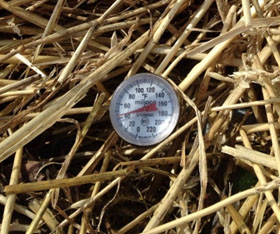
Soil temperatures under
straw mulch on strawberries.
Photo: M. Roegge.
We're still picking spinach from our tunnels, although the rate of growth is much reduced from normal due to the cloudy days we've had in March. Our head lettuce and romaine that we transplanted late last year survived the -10 degree temps in early January (helped with a 1 ounce row cover, triple layered). They too are slow growing due to cloudy days. We'll take the first heads next week.
We've had to treat for aphids in the spinach. It's difficult to eliminate these pests from the tunnel when growing a crop 12 months of the year, as there is a food source ever present. Even weeds can harbor aphids, so monitor the tunnel before spring planting to help alleviate unnecessary pests from developing early.
Straw removal for strawberry plantings should be done at 41-42 degree soil temperature, based on research conducted at the U of I. Too early and you run a higher ris k of late frost injuring the berries, remove the straw late and the plant will begin to grow under the straw. This winter we had a low of -10, so we are expecting a higher amount of leaf desiccation. We try and remove as much dead leaf tissue as possible to reduce incidence of leaf disease.
The plasticulture strawberries (under 1.5 ounce covers) look to have lost 60% or more of leaf area due to winter desiccation. As stated above, we remove as much dead leaf as possible to reduce disease issues. Done by hand, this can take considerable time.
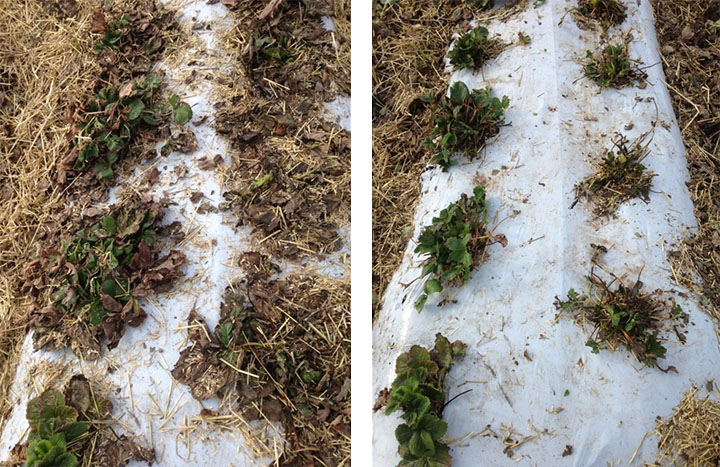
Plasticulture strawberries before (left) and after (right) cleanup of dead leaves after winter. Removal of the dead leaves helps to reduce botrytis. Photos: M. Roegge.
Row cover removal on plasticulture strawberries has usually occurred by now. Brad Bergefurd, OSU, recommends cover removal when temperatures average 50 degrees. But we usually remove a bit sooner to slow down growth as we don't utilize overhead irrigation and the covers can speed up growth by trapping heat. I was about to remove last week, but the weekend forecast will delay removal to this week.
Mike Roegge, Retired Extension Educator & Mill Creek Farms (roeggem@illinois.edu)
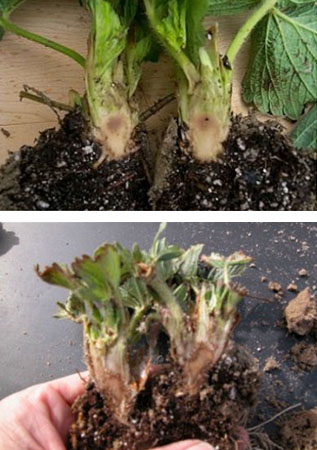
Source: Strawberry Growers Information
https://strawberries.ces.ncsu.edu
From the St. Louis Metro-east... This time last year, I was reporting on the March 14-15 freeze event and what effect it had on some of the in-bloom early blooming peach cultivars. What a difference a year can make. Last year, the average 4" bare ground maximum soil temperature for the first three weeks of March was 51.4° F. This year, over the same time period is averaging out at 40.4°F, and the difference shows phenotypically as well. Most apples are dormant to silver tip, whereas some of the early blooming cultivars like Braeburn, Granny Smith and Jonathan are just beginning to show signs of initial bud swell. Peaches at most are at swollen bud, and have been for about a week as temperatures remain in the 30's to low 40's. Cherries on dwarfing rootstock are at best in the initial stages of budburst, whereas larger trees are still tight. Although apricots are not a major crop, the few trees planted are noticeably in bud swell. Blackberries have broken bud, some cultivars more advanced than others. Prime-Ark Freedom, which appears to be low-chill cultivar, is reported to be at ½" shoot growth, whereas cultivars like Triple Crown are just at bud break. Covers are just coming off plasticulture strawberries in tandem with setup of frost protection irrigation systems.
January did deliver below zero temperatures, so growers are now scouting blackberries and strawberries for freeze injury symptoms. Freeze injury in strawberries is determined by cutting crowns lengthwise and inspecting the pith and cambial layer. Healthy tissue is whitish-green and freeze-damaged tissue is light- to dark-brown. The pith makes up the central core of the interior portion of the crown and is easily damaged by freezing temperatures. In the top picture is an example of a strawberry crown exhibiting "light" damage to the pith. The lower picture however, exhibits more extensive damage, not only to the entire pith but also the thin layer of cambial tissue surrounding the pith. With increasing levels of crown damage comes a reduction in yield potential.
Elizabeth Wahle (618-344-4230; wahle@illinois.edu)
From southern Illinois...We have been holding roughly around to maybe slightly below average on temperatures with highs mainly in the 40s and 50s and a few colder days. Spring welcomed southern Illinois with some light to moderate snow for a decent part of the day on Tuesday; however, temperatures had been warm enough that we did not get any accumulation from this storm system. We have had a few sunny days mid-week this week, but this has been countered with enough cloudy days lately that those sunny days are well appreciated. Over the weekend, we got 0.9" of rain here in Murphysboro and coupled with cooler temperatures and clouds the ground is very wet.
Out in the field our crops are showing some signs of life. Asparagus is starting to emerge; however, this morning (3/22) we got down to 26˚ so any emerged spears were completely froze. Most tree fruits still have fairly tight buds except for some of our earliest bloomers which buds are starting to swell. We are seeing shoot growth starting on some blackberries as the Kiowa we have here at the office have about 3/8 to ½" green shoots. To many, crop progress "feels" late overall after having some very warm and early springs especially last year, but looking back I think we are still about on average for our crop progress so far. We are getting ready to cut potatoes for a plasticulture potato variety trial that hopefully will get planted in the next week or two. In the high tunnel overwintering carrots and greens have really appreciated the sun and warmer temperatures in the last month and really have been pushing more growth. The forecast has some rain, but highs more in the 50s to about 60 which would be about average for this time of year.

Asparagus emergence starting (left) and first growth on blackberries in southern Illinois. Photos: N. Johanning
Nathan Johanning (618-939-3434; njohann@illinois.edu)
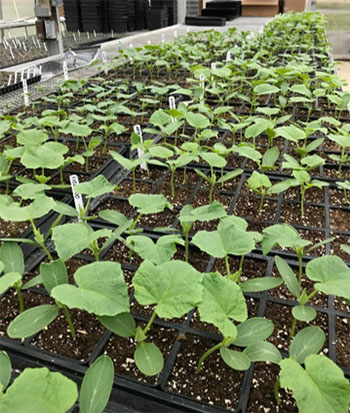
Cucumber transplants off and growing
for a cucumber variety trial in the high
tunnels. Photo: B. Aly
From Dixon Springs Agricultural Center... Work continues on the high tunnels with end wall plastic getting put on last week. On Sunday, March 11th, DSAC received a very wet, heavy snow event with localized accumulations of 4-6 inches. Snow had to be removed from the tops of the two tunnels that are skinned, and luckily this got done in a timely manner, with no damage to plastic or structures.
Cucumber, tomato, and pepper plants are growing quickly in the greenhouse and cucumbers will be ready to transplant into the hydroponic dutch buckets within the next week. Once electrical and irrigation systems are completed, then the first plants can get moved into the tunnel that is being set up for hydroponic production.
The propane heater in the greenhouse had to be replaced due to a cracked heat exchanger. Besides creating a horrific noise and being less efficient, this also created a situation that was releasing several pollutants, including carbon monoxide and nitrous oxide, into the greenhouse. This is unsafe for both people and plants. As a reminder to those running heaters, make sure equipment is in good operating condition and being correctly vented outside of the structure to avoid hazardous situations to yourself, employees, or your plants.
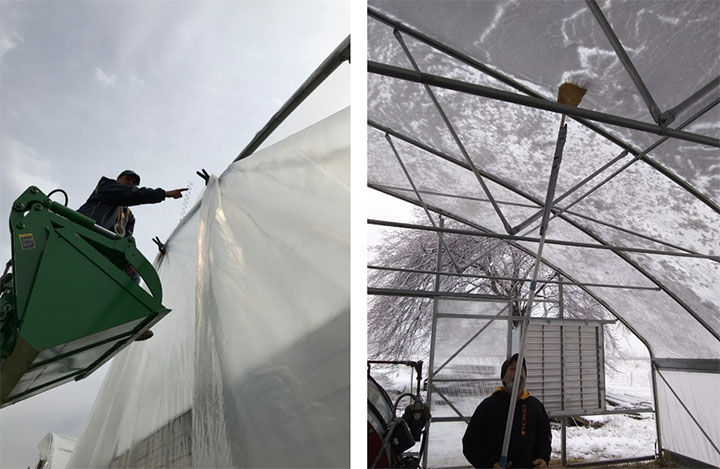
Plastic clamps come in very handy when needing to hold plastic in place while positioning and attaching with wiggle wire. Snow being removed from one of the tunnels at DSAC using brooms and towels attached to poles to push up on plastic. Notice how well the snow works as a shade cloth! Photos: B. Aly (left) & J. Zakes (right).
Bronwyn Aly (618-382-2662; baly@illinois.edu)
Fruit and Vegetable Production and Pest Management
Modified Growing Degree Days (Base 50°F, January 1 through March 19)
Station Location |
Actual Total |
Historical Average (11 year) |
One- Week Projection |
Two-Week Projection |
|---|---|---|---|---|
Freeport |
6 |
15 |
15 |
30 |
St. Charles |
21 |
18 |
30 |
47 |
DeKalb |
14 |
19 |
25 |
44 |
Monmouth |
22 |
32 |
36 |
59 |
Peoria |
33 |
38 |
48 |
72 |
Champaign |
34 |
42 |
50 |
72 |
Springfield |
58 |
49 |
76 |
101 |
Perry |
72 |
58 |
91 |
119 |
Brownstown |
78 |
74 |
99 |
129 |
Belleville |
105 |
90 |
129 |
162 |
Rend Lake |
109 |
96 |
135 |
170 |
Carbondale |
121 |
100 |
147 |
182 |
Dixon Springs |
153 |
117 |
182 |
219 |
Insect development is temperature dependent. We can use degree days to help predict insect emergence and activity. Degree day accumulations calculated using the Illinois IPM Degree-Day Calculator (a project by the Department of Crop Sciences at the University of Illinois and the Illinois Water Survey).
Kelly Estes, State Survey Coordinator, Illinois Cooperative Agricultural Pest Survey (217-333-1005; kcook8@illinois.edu)
Using Traps to Monitor Key Insect Pests in Tree Fruits
(This is an updated version of an article I included in this newsletter most springs before I retired ... lots of the info is the same, and it's all still relevant.)
For apple and peach growers who have not already done so, NOW is the time to order pheromone traps for key insects. Traps are available and useful for monitoring many insects of fruit crops; the ones listed in the table below are the most important for most Illinois tree fruit growers. Dogwood borer has become more troublesome to the east and northeast of us in dwarf apple trees, so increased attention to it is probably warranted here as well. Other tree fruit pests that may be worth monitoring with traps include spotted tentiform leafminer, redbanded leafroller, and obliquebanded leafroller in apples.
What kind of traps work best?
A few companies manufacture traps, and most have a similar range of designs. Trecé, Scentry, Suterra, Alpha Scents, and others are reliable providers. The trap design most widely used for fruit insects in general is the large plastic delta trap; Trecé calls it the Pherocon VI trap, and Suterra, Scentry, and others simply call it a large plastic delta trap (LPD). This trap is quick to set up and easy to maintain; the sticky trapping surface is provided by an exchangeable card that slides in and out quickly and easily. If you bring the trap "shell" indoors at the end of the season, you can expect to get at least 2 to 3 years use from each trap (while replacing lures and liners as needed).
How do traps work?
Most of the insects listed in the table below are moths in their adult stage. For all the moths typically monitored using sticky pheromone traps, the trap must be baited with a pheromone lure – usually a small piece of rubber or plastic containing a synthetic blend of chemicals that is very similar to compounds used by female moths to attract males of the same species. When traps capture male moths, that serves as an indication that females are also present, and mating and egg-laying are occurring. When you order pheromone traps, you also must order lures for the specific insect(s) you wish to monitor. (Sometimes you may order "kits" that contain enough traps, sticky liners, and lures to last the season.) Remember that although you may use the same type of trap to monitor different pests, you must use only a single lure per trap ... it does not work to put lures for codling moth and tufted apple bud moth in the same trap. Depending on the pest species, lures usually last 2 to 8 weeks (suppliers list the effective life of the lures they sell), so you have to order enough lures to last through the whole season.
For apple growers in the northern half of Illinois, monitoring the flight of apple maggot flies also is useful. Traps for apple maggot flies rely on appearance (especially the color and shape of a bright red apple) and the use of a food odor ("apple volatiles") instead of a pheromone, and they are designed to capture female apple maggot flies ready to lay eggs on fruit. All the major suppliers of insect traps carry these kinds of traps. Growers should order the red spheres, tubes or tubs of stick-um or tanglefoot, and the food lures recommended by the supplier. Apple maggot traps may be used without any food lures; counts are interpreted accordingly.
How many traps are needed for each pest species?
Guidelines usually recommend at least 3 traps per pest species for any orchard up to 10 acres in size and 1more trap for every 3 to 5 acres above 10. To monitor 50 acres of trees in 3 or 4 separate blocks, use 3 traps per block and at least 9-12 traps total ... for each pest species. Always use at least 3 apple maggot traps (red spheres) per block of trees. See the table below regarding placement of traps. Remember that you should check these traps and record counts in each at least twice per week.
If you have only one relatively small block of trees, you may want to order 3-trap "kits" that suppliers package for each of the major pests. Kits with "standard" lures will include 3 lures per trap, but because the lures for most will have to be replaced every 4 weeks, most Illinois growers will need yet another 2 extra lures per pest species per trap to get through the entire season. Suppliers also sell these extra lures and extra "liners" (the sticky trapping surface) for traps. If you operate an orchard larger than 10 acres, you'll need more traps, so don't "mess with" 3-trap kits; contact a supplier and order in bulk. "Long-life" lures are available for the codling moth and the Oriental fruit moth (and some other species) ... these lures last 8 weeks between changes and are usually the best choice.
For apple growers in southern Illinois, it has been several years since we saw serious problems with tufted apple bud moth in orchards that were treated pretty much exclusively with organophosphates. With greater reliance on alternative chemistries in recent years, this pest has faded from the scene in most orchards, but I still include it in the table below for those who encounter it.
As the season continues, I'll include some updates on what's happening with trap counts from a few locations and some guidelines on interpreting the information you gather by counting (and recording the counts) insects in traps.
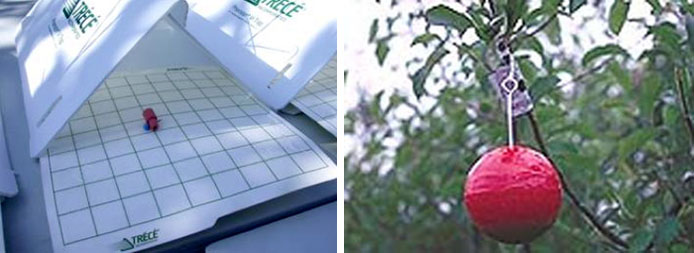
Left: A Pherocon VI trap (an example of a large plastic delta trap), with the sticky liner partially removed, showing a pheromone lure. Right: An apple maggot trap.
Pheromone trapping guidelines for major fruit insects
Crop and pest |
When should you use traps? |
Where do you hang the traps? |
Apples -- all of Illinois |
Early bloom through harvest |
At 6-7 feet or higher (upper third of canopy is best), spaced throughout the block, including one somewhere near the upwind edge and one near the downwind edge. |
Apples – all of Illinois |
Petal fall through harvest |
4 feet above the ground and within the tree canopy. (This height is very important, 1 foot higher or lower reduces attractiveness.) |
Apples -- south of I-70 |
April 15 through harvest |
Same as above for codling moth. |
Apples -- north of Springfield |
June 15 through harvest |
In the outer portion of the canopy of trees on the edge of the block ... VERY visible to adults flying into the block (remove foliage around the sticky red spheres). Hang in border rows or end trees nearest any woods or brush outside the block |
Peaches -- |
Bloom or petal fall through harvest |
Similar to codling moth, but trap height should not exceed 5 to 6 feet. |
Peaches – "greater" peachtree borer |
May 15 through harvest |
Similar to codling moth, but trap height should be 3-4 feet above the ground. |
Peaches -- |
Green tip to pink through harvest |
Similar to codling moth, but trap height need not exceed 6-7 feet. |
Midwestern suppliers of pheromone traps include:
Supplier |
Address |
Phone & Fax |
Great Lakes IPM |
10220 7563 N. Crystal Road |
989-268-5693 |
Gempler's |
P.O. Box 44993 |
1-800-382-8473 |
Contributions from Weinzierl Fruit and Consulting, LLC are provided through support by the Illinois Specialty Growers Association. Visit www.specialtygrowers.org for more information or to join the association.
Rick Weinzierl, Weinzierl Fruit and Consulting, LLC (217-621-4957; raweinzierl@gmail.com)
Concerns with Dicamba Drift
Dicamba resistant soybeans will be grown on a majority of acres in Illinois this year, in some locations across the state, up to 90% of the soybeans grown could be dicamba resistant. What this means to fruit and vegetable growers is you need to be VERY proactive and contact every soybean grower within several miles to inform them of your fruit/vegetable crop, many of which are susceptible to injury if drifted upon.
Dicamba is targeted to control broadleaf weeds, waterhemp in particular. Corn is not a broadleaf plant, so it is highly unlikely to be affected. Every grower in Illinois that applies dicamba is required to attend an educational session to help them understand the concern with off target movement of dicamba, to help prevent accidental damage to non-targeted fields.
Nearly all fruit and vegetable crops can be adversely affected by off target movement of dicamba, but tomato and grape are especially susceptible. You've probably seen the symptoms of 2,4-D injury, which is in the same family of herbicides as dicamba (plant growth regulators), where the new leaves that emerge are curled and elongated. If the susceptible plant is unable to metabolize the chemistry, it dies or can't outgrow the symptoms and is unproductive.
There are two ways that dicamba can move from the sprayed field, particle drift or vapor drift. Particle drift occurs during or immediately after application. It is caused by winds carrying the spray droplets downwind from the field. Inversion, a process where a cold layer of air caps the warm currents of air that arise from the ground, can trap very small particles of spray droplets that then can move off target. For particle drift, we can take steps to reduce the opportunities for off target movement by not spraying when the wind is in the direction of susceptible crops. We can somewhat accurately predict when and where inversions might occur, and through these educational sessions, pesticide applicators are being instructed on how to do so.
To me the more concerning method of pesticide drift is vapor drift. Vapor drift is when the pesticide, in this case dicamba, moves off the field as a vapor. This class of herbicides, phenoxys (which include Dicamba and 2,4-D), is one of the main herbicide classes that has the chemistry which allows vaporization to occur. The new formulation of dicamba being sold today has been altered to reduce vapor drift. However, over the past few years, weed scientists have found that this new formulation, once applied to the field, certain conditions alter this chemistry and it reacts similar to the old formulation, which was well known to vapor drift for miles.
For vaporization to occur, temperatures of approximately 85 degrees or higher must be present. This vaporization can occur for up to 5-6 days or longer after application, but is greatly reduced if rainfall occurs in the days following application. This is highly concerning, for as wind direction 5-6 days after application is an unknown. In 2017, the first year of the new dicamba formulation being labeled, there were a few instances of dicamba drift injuring susceptible fruit/vegetable crops. Be expecting more in 2018.
In 2017 there were only about 10 days in which the temperatures were in excess of 90 degrees in central Illinois last year. These were all in July. The hotter the temperatures, the more risk of volatilization. If temperatures are higher during the early part of summer (late May and June) when most post emerge soybean herbicide applications take place, there could be a potential for increased amounts of dicamba drift injury.
So notify all neighbors within several miles and inform them of your susceptible crop. Also, make sure you farm is registered at https://driftwatch.org! DriftWatch is a web site that allows you to input your locations of susceptible crops that applicators can review prior to dicamba application. Be sure to register on that site. This helps to show you as a specialty crop grower are doing you due diligence to make known that sensitive crops are present. The IL Dept. of Ag has inspectors located across the state that, once notified, will perform an on-site inspection of any suspected herbicide off target damage. You must contact them immediately if you suspect injury.
A big concern is that symptoms on the newly emerging leaves of injured plants don't usually appear until a week or longer after drift occurs. It can be difficult to assign blame to a particular application since vapor drift can occur from a field several miles away and up to 5-6 days or later after application. So how do you prove where or when the alleged spray application that could have drifted occurred? Who can you seek compensation for damages when the off target drift can't be identified? Hopefully, some good neighborly relations fostered now can avoid you having to worry about these questions later.
Mike Roegge, Retired Extension Educator & Mill Creek Farms (roeggem@illinois.edu)
Less Seriously...
http://www.primarygames.com/seasons/spring/jokes.php
Q: What does the Easter Rabbit get for making a basket?
A: Two points just like everybody!
Q: When do monkeys fall from the sky?
A: During Ape-ril showers!
Q: Why is the letter A like a flower?
A: A bee (B) comes after it!
Q: Can February March?
A: No, but April May!
Q: Do you know all about April 1st?
A: Yes, I'm fooly aware of it!
Q: What bow can't be tied?
A: A rainbow!
Q: What do you call a rabbit with fleas?
A: Bugs Bunny
Q: Why is everyone so tired on April 1?
A: Because they've just finished a long, 31 day March!
Q: Why did the farmer bury all his money?
A: To make his soil rich!
Q: What did the big flower say to the little one?
A: You're really growing, bud!
Q: Why are frogs so happy?
A: They eat whatever bugs them.
Q: What flowers grow on faces?
A: Tulips (Two-lips)!
Q: What can be seen in the middle of the months 'April' and 'March', that cannot be seen in the beginning or end of either month?
A: The letter "r".
Q: What's a baby chick's favorite plant?
A: EGG-plants!
Q: What do you get when you plant kisses?
A: Tulips!
Q: What falls but never gets hurt?
A: The rain!
Q: What is a spring chick after it is five months old?
A: Six months old.
Q: Why did the boy start a gardening business?
A: Because he wanted to rake in the cash!
Q: What did the summer say to the spring?
A: Help! I'm going to fall.
Q: What kind of garden does a baker have?
A: A "flour" garden.
Q: Why did the farmer plant a seed in his pond?
A: He was trying to grow a water-melon.
University of Illinois Extension Specialists in Fruit and Vegetable Production & Pest Management
Extension Educators – Local Food Systems and Small Farms |
||
Bronwyn Aly, Gallatin, Hamilton, Hardin, Pope, Saline, and White counties |
618-382-2662 |
|
Katie Bell, Franklin, Jackson, Perry, Randolph, & Williamson counties |
618-687-1727 |
|
Sarah Farley, Lake & McHenry counties |
847-223-8627 |
|
Nick Frillman, Woodford, Livingston, & McLean counties |
309-663-8306 |
|
Laurie George, Bond, Clinton, Jefferson, Marion, & Washington counties |
618-548-1446 |
|
Zachary Grant, Cook County | 708-679-6889 | |
Doug Gucker, DeWitt, Macon, and Piatt counties |
217-877-6042 |
|
Erin Harper, Champaign, Ford, Iroquois, and Vermillion counties |
217-333-7672 |
|
Grace Margherio, Jackie Joyner-Kersee Center, St. Clair County |
217-244-3547 |
|
Grant McCarty, Jo Daviess, Stephenson, and Winnebago counties |
815-235-4125 |
|
Katie Parker, Adams, Brown, Hancock, Pike and Schuyler counties |
217-223-8380 |
|
Kathryn Pereira, Cook County |
773-233-2900 |
|
James Theuri, Grundy, Kankakee, and Will counties |
815-933-8337 |
|
Extension Educators – Horticulture |
||
Chris Enroth, Henderson, Knox, McDonough, and Warren counties |
309-837-3939 |
|
Richard Hentschel, DuPage, Kane, and Kendall counties |
630-584-6166 |
|
Andrew Holsinger, Christian, Jersey, Macoupin, & Montgomery counties |
217-532-3941 |
|
Extension Educators - Commercial Agriculture |
||
Elizabeth Wahle, Fruit & Vegetable Production |
618-344-4230 |
|
Nathan Johanning, Madison, Monroe & St. Clair counties |
618-939-3434 |
|
Campus-based Extension Specialists |
||
Kacie Athey, Entomology |
217-244-9916 |
|
Mohammad Babadoost, Plant Pathology |
217-333-1523 |
|